I'm nearly finished with the journal I started in January. It’s beautiful, much like the last one that took me two years to fill. The other journal, a custom gift from a friend and mentor, is even more special to me. Both are filled with layered, textured palimpsests of collage art that often attempt to blot out my feelings of sadness and rage. These feelings—intense and ugly on the pages—usually simmered as a vague malaise in my waking life because I was often dissociated, avoiding and abandoning myself, my journal too.
I’m finally beginning to emerge from that self-abandonment, feeling all the sadness and rage associated with becoming less estranged from myself. Completing my journal eight months into the year feels like a testament to that, yet the process of changing is still unfolding so slowly, on a timeline that doesn’t align with the fantasy in my head. If it were up to me, I’d be realizing myself and self-actualizing much sooner. I have tried to accelerate the process with gimmicks like rapid weight loss, and a reactionary podcast. These gimmicks made me feel more productive than I actually was while I pushed through mild brain damage from a vitamin deficiency due to starvation that made it nearly impossible to consistently journal or stay focused on my goals.
The best gimmicks come to me during bouts of interrupted sleep. That is when I become a student of neuroplasticity, growth hacking, manifestation, human design, shadow work and astrology by way of Tiktok. Crunching the numbers like the meme of the guy with the complicated formulas on the chalkboard, I do supermath, multiplying the blessings promised at the intersection of science and woo-woo.
A woman calling me “bestie” in an overfamiliar tone insists that I purchase a product from the Tiktok shop. I venture to her profile where there’s a curated playlist of affirmations and a playlist discussing various healing modalities. She is not a licensed therapist or doctor, despite performing therapy in front of her camera.
The infomercials on basic cable back in the basement of my childhood home came to me during similar bouts. I would sit transfixed by the glow of the old school, fat-backed television as a familiar mantra repeatedly buzzed: “Call now—this amazing offer won’t last long!” The ad’s narrators always promised fulfillment with such urgency, and I would believe them every time because I desperately wanted to be cured of being a modern girl.
Similarly, watching Oprah in the 1990s and 2000s quelled my desperation and hopelessness with an almost irresistible urge to act, though I never quite made it off the couch. Oprah was everything—a teacher, cultural critic, therapist, and spiritual advisor rolled into one—even before our information-dense culture demanded it.
Gullibility and susceptibility are directly proportional to that hopelessness, that desperation. All these years later, I still often feel desperate and hopeless enough to call the number on the screen, even as the numbers and the screens have changed. I still cling to empty Oprahisms like Reva does in My Year of Rest and Relaxation. I still crave the fast-food fantasy of change as the solution to the modern problem of identity (and the modern problem of the performance of identity as capital), as the solution to the hopelessness it produces as well. I’m no less immune to the allure of the gimmick or the despair that drives us toward it. This hopelessness pushes us to speed-run self-actualization alongside self-optimization because careerism, the persona realm, and the performance of identity for capital demand it. This is an exploitable condition under capitalism. It’s the space from which the identity of the therapist is performed and commodified on TikTok, outside its traditional context, and the space many try to perform the identity of a writer on Substack.
Identities—the desires, politics, and social constructions of them—aren’t solely our own. They are communally authored, shaped by a never-ending dialogue with the world, the social internet, and the systems and algorithms of modernity we’ve all found ourselves ensnared in due to the widening information sphere and platform capitalism, contributing to an increasingly intuitive, mimetic, and vibes-oriented cultural landscape. In the age of hyperreal individualism, there is only post-truth “identity performances, aesthetics, affects, symbols, signals, and gestures” meant to alchemize us from girls into gimmicks.
To become a gimmick itself—no credentialism, just vibes—is to be consumed by those seeking language, tools, and frameworks to fill their voids. They graft our words and highly curated identities onto their own like collage, becoming one—not with the universe—but with the gimmick girl, mimetically intertwined with and -pilled by her, wholly supplanted by knowledge divined from her at a pace that aligns with the limitless vision of “having it all,” which includes hypervisibility.
Writer is an easier identity to adopt than therapist, especially with the use of aesthetic cues that make the adoption even simpler. Anyone can be a writer, bypassing the hopelessness—and the labor of real change (practice, apprenticeship, schooling, professionalizing, being edited and mentored)—for a dubious performance of it. Hypervisibility through the aesthetics of information is what it means to be a writer now. It means being a glamorous philosopher, a hot-girl social critic, an esoteric baddie, a femcellectual, a hegelian e-girl, a nymphet public intellectual, a literary it girl, a thought daughter, a gimmick girl.
On Substack, demonstrating competency isn’t a quality issue; it’s about how well you can perform the gimmick—the identity of a writer online—not just for your readers, but also for media workers eager to capitalize on the aesthetics of information with their link round-ups, yet panicked by less credentialed writers doing the same.







wonderful essay. very relatable. this reminded me of the consistent feeling of emerging from and into a dissociative state.
and this having much to do with the allure of rapid fixes through "gimmicks" and the commodification of identity that is constantly within the pressure cooker. we/i often face these moments of dissociation because of the tension between authentic self-exploration and the performative identities that our contemporary culture often demands.
the difficulty is (even during the moments of escape from disassociation) we continually witness the erasure of our potentially discovered authentic self.
i agree with every single word in this essay. you nailed it when you discussed the performance that comes into play when assigning oneself or working to fit into a specific gimmick or aesthetic. such a wonderful piece from an incredible writer💓